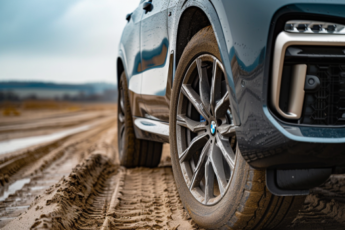Last Updated on 4 weeks
Unraveling the Mystery: Which Tire Type Suits You Best?
Choosing the right tires for your vehicle is crucial for safety and performance. With a vast array of options, including all-season, summer, winter, touring, performance, all-terrain, and mud tires, it’s essential to understand the capabilities and limitations of each type. When deciding, consider vehicle requirements, climate, driving conditions, comfort preferences, and mileage expectancy. Refer to Tire Rack’s Tire Decision Guide or consult manufacturers for updated tire information to ensure the best fit for your vehicle.
Key Takeaways
- All-season tires offer balanced capabilities for varied weather conditions.
- Summer tires excel in warm weather, providing increased traction and handling.
- Winter tires are crucial for optimum snow, slush, or ice traction in colder climates.
- Touring tires combine comfort with performance for an enhanced driving experience.
- Performance tires are ideal for drivers seeking superior handling and braking capabilities.
- All-terrain and mud tires are tailored for off-road driving and challenging terrains.
- The correct tire size, speed rating, and tread-wear rating are essential for maintaining optimal vehicle function.
Understanding Different Tire Types
Tires come in different varieties to cater to specific driving conditions and vehicle performance requirements. It is vital to understand the purpose behind each tire type to select the right tire for your vehicle and driving needs. This section will discuss the various types of tires, including all-season, winter, summer, performance, touring, all-terrain, and mud tires.
The Essentials of Tire Varieties and Their Purposes
Each type of tire serves a unique purpose:
- All-season tires offer balanced capabilities for varied weather conditions, making them suitable for various diseases and commonly found on vehicles from the factory.
- Winter tires and summer tires specialize in providing optimal traction in their respective climates, ensuring safe driving in extreme weather conditions.
- Touring and performance tires enhance driving experiences with improved handling and comfort, catering to drivers seeking a quiet, smooth ride or enhanced vehicle handling.
- All-terrain and mud tires offer the ruggedness needed for challenging terrains, making them ideal for off-road enthusiasts.
Decoding Tire Types: From All-Season to Performance
Here’s a closer look at the characteristics of each type of tire:
Deciphering the types of tires and their intended uses is crucial for optimal vehicle performance.
| Tire Type | Characteristics | Best Suited For |
|---|---|---|
| All-Season Tires | Versatile, suitable for various weather conditions, and commonly comes as factory standard on many vehicles. | Drivers are experiencing mild seasonal changes, and drivers are prioritizing longer tire life. |
| Winter Tires | Designed for optimal traction in cold temperatures, improving grip on snow and ice. | Drivers in colder climates who regularly face snowy and icy conditions. |
| Summer Tires | Optimized for warm weather and dry and wet conditions, providing enhanced traction and handling. | Drivers in warm climates seeking a tire for better steering response and reduced hydroplaning. |
| Touring Tires | Combines comfort and performance, offering better handling, reduced road noise, and a quieter, smoother ride. | Drivers are seeking comfort and performance for everyday driving. |
| Performance Tires | Engineered for enhanced handling, grip, and high-speed cornering, it is often used on sports cars. | Driving enthusiasts and owners of sports cars or performance sedans. |
| All-Terrain Tires | Capable of handling both on-road and off-road driving scenarios with aggressive tread patterns. | Drivers who regularly transition between on-road drives and off-road adventures. |
| Mud Tires | Designed for navigating through muddy terrain and providing maximum traction in challenging, slippery conditions. | Off-road enthusiasts are driving on muddy trails and requiring specialized traction. |
Understanding the different types of tires and their capabilities is the first step in making an informed decision when choosing the right tire for your vehicle and specific driving needs.
Advantages of All-Season Tires
All-season tires have gained widespread popularity among drivers by offering a well-balanced solution for those who need year-round performance without switching tires seasonally. This section will delve deeper into the benefits of opting for all-season tires, their limitations, and why many motorists often choose them as the go-to tire type.
Balancing Performance Across Various Conditions
All-season tires are designed to provide adequate performance throughout the year in different weather conditions, ensuring a smooth driving experience with some snow capability. These tires balance ride quality, handling, noise reduction, and wet-weather grip, suitable for various driving conditions.
Some all-season tires, such as high-performance, deliver better road confidence and sportier driving dynamics. In contrast, grand touring all-season tires trade off some handling for a more comfortable ride. The emergence of “all-weather” tires narrows the gap with winter tires by offering almost comparable snow traction.
What Makes All-Season Tires a Popular Choice?
A key feature contributing to the popularity of all-season tires is their versatility. Their ability to handle diverse driving conditions without the need for seasonal tire changes makes them a suitable option for drivers who live in areas with moderate climates and experience occasional extreme weather conditions.
Note:
All-season tires are known to offer better dry braking, noise reduction, and overall comfort, appealing to a broad range of drivers, and generally providing long-term value with a lifespan of 50,000 to 85,000 miles.
Limitations of All-Season Tires
While all-season tires are an excellent solution for many drivers, they have some limitations. In specific conditions, such as snow or wet roads, these tires provide only standard braking performance and may deliver middle-of-the-road handling compared to specialized weather tires.
| Weather Conditions | All-Season Tires | Specialized Weather Tires |
|---|---|---|
| Snow | Standard Braking Performance | Superior Braking Performance |
| Wet Roads | Standard Braking Performance | Improved Braking Performance |
| Dry Roads | Better Dry Braking | Varies Depending on Tire Type |
Drivers who regularly face extreme weather conditions or require superior handling and traction may find the design compromises of all-season tires unsatisfactory. Recognizing these trade-offs is crucial in determining whether all-season tires suit your driving needs.
The Superiority of Summer Tires in Warm Climates
Summer tires, also known as “three-season” tires, are specifically designed for optimal performance in warmer weather conditions, providing drivers with many benefits in dry and wet situations. In this section, we explore the advantages of choosing summer tires in hot climates and how they can significantly improve your driving experience during the hotter months.
These tires are engineered to perform best at temperatures above 40 degrees Fahrenheit, making them a top choice for drivers in hotter climates. The design of summer tires ensures improved traction and handling on both dry and wet surfaces, tackling issues such as hydroplaning effectively. The superior grip enhances steering response and reduces braking distance, providing a responsive and safer drive.
Some of the key summer tire benefits include:
- Optimized dry and wet traction
- Better steering response
- Shorter braking distance
- Increased cornering abilities
While summer tires excel in certain aspects, they may lead to increased road noise and reduced comfort compared to other tire types, such as all-season or touring tires. However, their optimal summer tire performance makes them a preferred warm climate tire choice for drivers prioritizing enhanced handling and safety during the hot months of the year.
“Summer tires are designed to perform optimally in both wet and dry conditions, making them an essential choice for drivers in hot climates where these conditions are common.”
It is essential to note that summer tires typically span 20,000 to 40,000 miles. Although they might wear out quicker than all-season tires, their exceptional performance in warm weather conditions makes them the best choice for drivers in such climates.
Why Winter Tires Are Essential for Cold Weather

Understanding the importance of winter tires is crucial for drivers who experience colder climates. These specialized tires are designed to provide optimal traction and performance in snow, slush, or ice, making them an essential addition to vehicles in areas where temperatures regularly dip below freezing.
Winter tires excel in conditions below 40 degrees Fahrenheit, surpassing other tire types in performance on snowy roads. The enhanced braking and handling offered by winter tires lead to a safer driving experience, setting them apart from all-season options. One unique feature of winter tires is their tread design, which allows snow to compact within the grooves, improving grip and providing confident control in slippery situations.
While winter tires might not deliver the same performance in dry conditions, the safety benefits they offer in severe weather are undeniable. For those living in areas prone to freezing temperatures, these tires are a cold-weather tire necessity. With a typical lifespan ranging from 30,000 to 40,000 miles, depending on use, winter tires are a sound investment for drivers who need added security during colder months.
“Winter tires provide crucial traction, performance, and safety for drivers navigating unpredictable winter weather.”
Before embarking on a winter driving journey, consider the benefits of winter tires:
- Improved traction: Winter tires are specifically designed to grip snowy, icy, and slushy roads, helping prevent accidents caused by sliding or skidding.
- Better braking: The unique tread design on winter tires dramatically shortens braking distances on slippery surfaces, ensuring a safer drive.
- Superior handling: The enhanced traction and control offered by winter tires result in a more stable, confident driving experience.
- Longevity: Using winter tires during colder months can extend the life of your all-season or summer tires by preserving them for use in higher temperatures.
To make the most of your winter tires and ensure safe, confident driving, it’s important to install these tires on all four wheels. This provides consistent traction and performance, proper balance, and handling on icy or slippery roads. Always replace your winter tires with all-season or summer ones once temperatures rise above 40 degrees Fahrenheit.
In conclusion, the essential winter tire traction of these specialized tires transforms winter driving from a treacherous ordeal into a more controlled and secure experience. Consider these benefits and switch to winter tires when the thermometer drops, ensuring a safer drive on cold weather roads.
Combining Comfort and Performance: Touring Tires Explained
Touring tires offer a desirable blend of ride quality with touring tires, comfort and handling by combining the practicality of all-season tires with enhanced performance. These performance and comfort tires are designed to provide a smoother, quieter ride than standard all-season options, thanks to their superior noise reduction capabilities.
Upgrading your ride quality with touring tires can result in a more enjoyable driving experience, without sacrificing too much of your all-season tire features.
While maintaining similar traction and braking abilities to their all-season counterparts, touring tires boast better handling and cornering performance. This is achieved through their wider tread design, which, unfortunately, may contribute to lower fuel efficiency. However, these touring tires advantages generally come at a higher price point than standard tires but promise a longer lifespan, ranging from 55,000 to 60,000 miles.
| Tire Type | Traction and Braking | Noise Reduction | Ride Quality | Handling and Cornering |
|---|---|---|---|---|
| All-Season Tires | Standard | Standard | Standard | Standard |
| Touring Tires | Similar to All-Season | Improved | Improved | Improved |
Touring tires are an excellent option for drivers searching for a more comfortable and refined driving experience without completely forgoing the value of all-season tires. They offer a great balance of performance, handling, and noise reduction, perfect for those prioritizing quality and comfort in their driving experience.
- Touring tire’s advantages include a quieter, more comfortable ride
- Improved handling and cornering for a better driving experience
- Extended lifespan compared to standard all-season tires, which provides longer-lasting value
In conclusion, upgrading your ride quality with touring tires is a worthy investment for drivers desiring the perfect combination of comfort and performance. With their improved noise reduction, handling, and extended lifespan, these tires provide a vastly enhanced driving experience without compromising the practicality of all-season tires.
Performance Tires for the Driving Enthusiast

Performance tires are the driving enthusiast tire choice for those who seek superior handling and braking capabilities, especially when it comes to high-speed cornering and quick stops. Ideally suited for sports cars and performance sedans, these tires feature higher speed ratings and improved overall performance potential compared to standard models.
How Performance Tires Enhance Your Driving Experience
While performance tires may offer less gas mileage and a rougher ride than touring tires, their primary design focus is maximizing grip in dry and sometimes wet conditions. This results in enhanced tire handling and overall improved driving experience. A few performance tire features that contribute to their appeal include:
- Greater handling precision and responsiveness
- Improved cornering ability
- Shorter braking distances
- Increased traction and grip on diverse road surfaces
Due to their design, performance tires may have a lifespan of up to 50,000 miles. However, certain factors, such as aggressive driving or using heavier, more powerful vehicles, can lead to quicker wear.
Performance tires are explicitly tailored to suit the needs of driving enthusiasts who desire exceptional handling abilities and superior braking performance for their vehicles.
| Performance Tires Features | Standard Tires Features |
|---|---|
| Improved handling and responsiveness | Typical handling and responsiveness |
| Shorter braking distances | Longer braking distances |
| Better cornering abilities | Standard cornering abilities |
| Greater traction and grip | Standard traction and grip |
| Potentially more rapid wear | Standard wear rate |
In conclusion, performance tires are excellent for drivers prioritizing optimal vehicle handling and braking capabilities. By understanding the performance tire features and selecting the right tires for your specific needs, you can significantly enhance your driving experience.
The Off-Road Adventurer’s Choice: All-Terrain Tires
When to Choose All-Terrain Tires for Your Vehicle
All-terrain tires are an excellent choice for drivers frequently transitioning between on-road drives and off-road adventures. With their aggressive tread pattern, these tires are suitable for various terrains, from rocky trails to muddy paths, providing reliable traction off-road while still maintaining on-road manners.
Some all-terrain tires have a higher load-carrying capacity, making them suitable for SUVs and trucks. However, they may generate more road noise and not excel in extreme weather conditions. The all-terrain tire selection ensures durability and versatility with an average lifespan of around 40,000 miles.
Understanding the Durability and Use Cases of All-Terrain Tires
All-terrain tires are designed for durability and can withstand the demands of off-road conditions, such as gravel, dirt, and rocks, while still performing adequately on paved roads. This versatility makes them a popular off-road tire choice for SUVs and truck drivers in everyday road travel and off-road excursions.
They offer balanced performance, with some models featuring reinforced sidewalls for added resistance against punctures and damage. Despite being more susceptible to certain types of wear, all-terrain tires remain a reliable option for those who want a tire to tackle diverse driving environments. The table below highlights some common use cases for versatile all-terrain tires:
| Use Case | Description |
|---|---|
| Rocky Terrain | All-terrain tires easily navigate rocky surfaces thanks to their robust tread pattern and reinforced sidewalls. |
| Muddy Paths | Their aggressive tread design enables all-terrain tires to provide reliable traction on muddy surfaces. |
| Sand and Dirt | These tires excel in loose and sandy terrain, maintaining stability and traction even on uneven surfaces. |
| Snow | While not specifically designed for snow, many all-terrain tires perform decently in light snow conditions. |
| On-Road Performance | All-terrain tires maintain on-road manners, allowing for comfortable everyday driving without significant compromises. |
In conclusion, all-terrain tires are a practical solution for drivers seeking a balance between off-road capability and on-road comfort, making them an ideal choice for various driving adventures.
Mud Tires: Mastering the Most Challenging Terrains
Among various tires, mud tires are designed specifically for drivers who love off-road adventures and regularly face challenging terrains. Their unique features and capabilities make them the perfect partner for tackling muddy landscapes. Let’s examine what makes them capable and how they fare against other specialized off-road tires.
“Mud tires are specially engineered for navigating through terrains covered in mud, offering superior traction compared to other tire types.”
Mud tires are designed with their mud tires capability in mind, focusing on providing exceptional traction and grip on slippery, muddy landscapes. This is achieved due to their aggressive tread patterns and large lugs that ensure no mud gets trapped as the tire rotates, thereby preventing buildup and maintaining a strong grip on the terrain.
However, these specialized tires also have some limitations. Due to their intense focus on tackling muddy terrains, mud tires may create excessive road noise, vibrate if driven on pavement, and lead to lower fuel efficiency compared to other types of tires. As with any other tire type, weighing the pros and cons is important based on your needs and driving conditions.
| Mud Tires | All-Terrain Tires |
|---|---|
| Optimized for muddy terrains | Versatile for various off-road conditions |
| Aggressive tread pattern | The less aggressive tread pattern |
| Superior traction in mud | Well-rounded performance off-road |
| It may create more road noise | Quieter on pavement |
| Faster wear rate when driven on pavement | Slower wear rate on pavement |
In conclusion, mud tires offer unparalleled traction and performance if you are an off-road enthusiast dealing with muddy terrains. However, all-terrain tires might be better for those who occasionally venture off-road and require a more balanced tire. It’s important to consider your driving conditions and preferences when choosing challenging terrain tires.
The Importance of Tire Size and Other Factors in Choosing Tires
Selecting the correct tire size is crucial for maintaining the performance and safety that your vehicle was engineered for. Recognizing the importance of tire size will ensure optimal handling, fuel efficiency, and tire longevity. The tire size is indicated by a series of numbers and letters, such as 245/40-R18, which specifies the tire width, aspect ratio, and diameter – all important attributes for fitment.
Other factors to consider when selecting the right tire size and making informed tire factors and choices include speed rating—indicating the tire’s maximum speed capability—and tread-wear rating, which gives an estimate of the tire’s lifespan. It’s advisable to match your replacement tire size to the original equipment specifications or consider an equivalently rated tire to maintain optimal vehicle function.
Pro Tip: Always refer to your vehicle’s owner’s manual or consult a tire professional to make sure you’re selecting the proper tire size and type for your specific vehicle and driving needs.
Here are some additional factors to consider when choosing new tires:
- Tire load capacity
- Wet and dry traction
- Ride comfort and noise level
- Overall tread life
- Fuel efficiency
- Price
Choosing a tire that balances your vehicle’s requirements, driving conditions, and personal preferences is essential. To help you with your decision-making process, the table below summarizes key attributes of different tire types:
| Tire Type | Primary Features | Best Suited For |
|---|---|---|
| All-Season | Versatile, good traction in various weather conditions, long tread life | Drivers experiencing moderate weather changes |
| Summer | Improved performance in warm weather, optimized traction in dry and wet conditions | Hotter climates and performance vehicles |
| Winter | Excellent traction in snow and slush, purpose-built for cold temperatures | Colder climates with regular snowfall |
| Touring | Comfortable ride, reduced road noise, balanced performance | Drivers valuing comfort and smooth ride |
| Performance | Superior handling, enhanced cornering, and braking capabilities | Sports cars and performance sedans |
Remember, your safety and enjoyment on the road rely heavily on your tire selection. Take your time to research and weigh each factor, and when in doubt, reach out to a professional tire dealer for guidance.
Conclusion
Choosing the right tire type is crucial to ensure safety, performance, and driving satisfaction. Each tire type caters to specific demands and driving conditions, making it essential to understand your needs when selecting tires. All-season tires offer versatility for a wide range of drivers, while specialized summer and winter tires address the needs of those in extreme climates.
For those seeking improved comfort or handling, touring and performance tires provide the desired upgrade over standard models. Off-road adventurers can rely on the rugged design of all-terrain and mud tires to tackle challenging landscapes. Remember to consider factors such as tire size, speed rating, and tread-wear when choosing tires to ensure a perfect match for your vehicle and driving preferences.
In summary, the best tire type for you depends on your unique needs, location, and vehicle requirements. By carefully assessing these factors and understanding your driving conditions, you can decide which tire type will provide an optimal driving experience. Stay informed on the latest tire advancements and explore options to ensure you’re always equipped with the right tires for a safe and enjoyable ride.
FAQ
What are the main types of tires available?
The main types of tires include all-season, summer, winter, touring, performance, all-terrain, and mud tires. Each type serves a distinct purpose and is designed to perform optimally under specific driving conditions and vehicle requirements.
How do I choose the right tire for my vehicle?
Consider your vehicle’s requirements, typical climate and driving conditions, comfort preferences, and mileage expectancy. Consult your vehicle’s manufacturer or refer to Tire Rack’s Tire Decision Guide for guidance in selecting the right tire.
What are the advantages and limitations of all-season tires?
All-season tires offer balanced performance across various weather conditions, providing a smooth driving experience with some snow capability. However, they may not deliver as well as specialized seasonal tires in extreme weather conditions or when superior handling and traction are required.
Do I need winter tires if I already have all-season tires?
If you live in an area with harsh winter weather or temperatures regularly dropping below freezing, switching to winter tires is recommended for improved traction and safer driving in snow, slush, or icy conditions. While all-season tires offer some snow capability, they fall short in performance compared to winter tires.
What’s the difference between touring tires and performance tires?
Touring tires combine the practicality of all-season tires with improved performance and comfort, offering a quieter and smoother ride compared to standard tires. Performance tires are designed for enhanced handling and braking, making them ideal for sports cars and performance sedans with higher speed ratings and improved grip.
When should I consider using all-terrain tires?
All-terrain tires are a good option for drivers who frequently transition between on-road driving and off-road adventures. They offer a balance between on-road manners and off-road capabilities, making them suitable for SUVs, trucks, and vehicles used for both everyday travel and off-road excursions.
How do I determine the correct tire size for my vehicle?
Consult your vehicle’s owner’s manual or the information provided on the driver-side doorjamb to find the recommended tire size. Tire size is indicated by numbers and letters, such as 245/40-R18, typically specifying tire width, aspect ratio, and diameter. Using the correct tire size for optimal vehicle performance and safety is essential.
Source Links
Types of Tires for Different Terrains: A Complete Guide to Choose the Best











